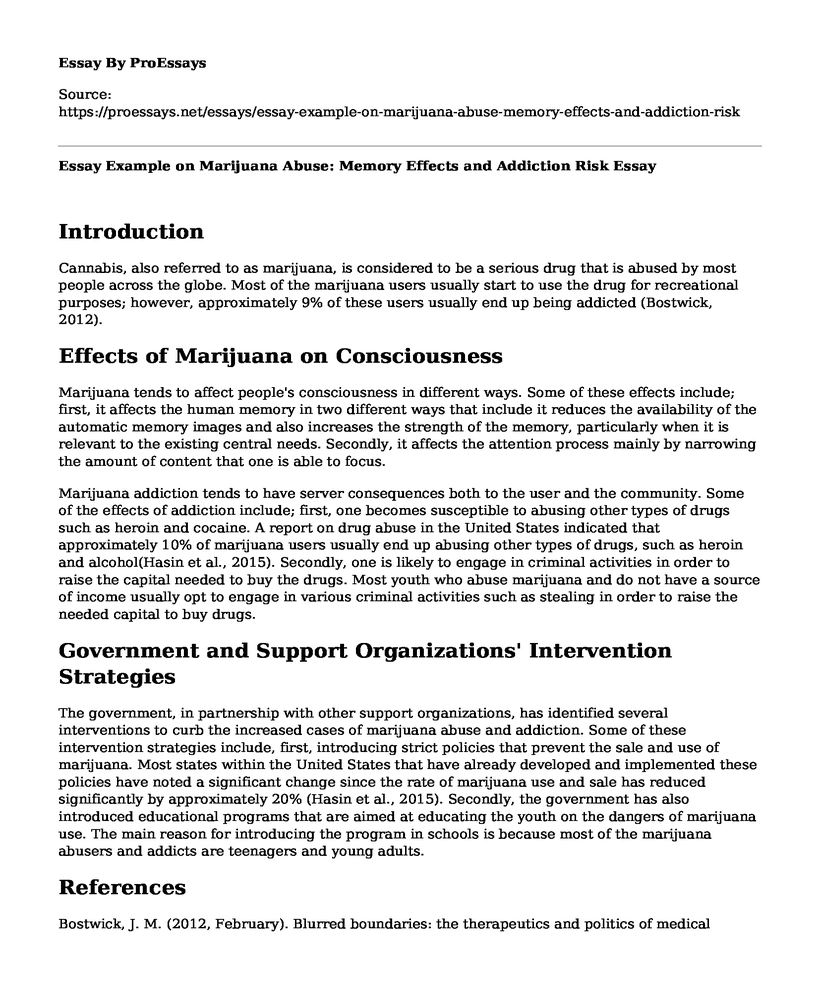Introduction
Cannabis, also referred to as marijuana, is considered to be a serious drug that is abused by most people across the globe. Most of the marijuana users usually start to use the drug for recreational purposes; however, approximately 9% of these users usually end up being addicted (Bostwick, 2012).
Effects of Marijuana on Consciousness
Marijuana tends to affect people's consciousness in different ways. Some of these effects include; first, it affects the human memory in two different ways that include it reduces the availability of the automatic memory images and also increases the strength of the memory, particularly when it is relevant to the existing central needs. Secondly, it affects the attention process mainly by narrowing the amount of content that one is able to focus.
Marijuana addiction tends to have server consequences both to the user and the community. Some of the effects of addiction include; first, one becomes susceptible to abusing other types of drugs such as heroin and cocaine. A report on drug abuse in the United States indicated that approximately 10% of marijuana users usually end up abusing other types of drugs, such as heroin and alcohol(Hasin et al., 2015). Secondly, one is likely to engage in criminal activities in order to raise the capital needed to buy the drugs. Most youth who abuse marijuana and do not have a source of income usually opt to engage in various criminal activities such as stealing in order to raise the needed capital to buy drugs.
Government and Support Organizations' Intervention Strategies
The government, in partnership with other support organizations, has identified several interventions to curb the increased cases of marijuana abuse and addiction. Some of these intervention strategies include, first, introducing strict policies that prevent the sale and use of marijuana. Most states within the United States that have already developed and implemented these policies have noted a significant change since the rate of marijuana use and sale has reduced significantly by approximately 20% (Hasin et al., 2015). Secondly, the government has also introduced educational programs that are aimed at educating the youth on the dangers of marijuana use. The main reason for introducing the program in schools is because most of the marijuana abusers and addicts are teenagers and young adults.
References
Bostwick, J. M. (2012, February). Blurred boundaries: the therapeutics and politics of medical marijuana. In Mayo Clinic Proceedings (Vol. 87, No. 2, pp. 172-186). Elsevier. Retrieved from https://www.mayoclinicproceedings.org/article/s0025-6196(11)00021-8/fulltext
Hasin, D. S., Saha, T. D., Kerridge, B. T., Goldstein, R. B., Chou, S. P., Zhang, H., ... & Huang, B. (2015). Prevalence of marijuana use disorders in the United States between 2001-2002 and 2012-2013. JAMA Psychiatry, 72(12), 1235-1242. Retrieved from https://www.ncbi.nlm.nih.gov/pmc/articles/PMC5037576/.
(n.d.). Retrieved March 3, 2020, from https://digital-films-com.nl.idm.oclc.org/p_ViewVideo.aspx?xtid=36368&loid=37678&tScript=0
Cite this page
Essay Example on Marijuana Abuse: Memory Effects and Addiction Risk. (2023, Apr 09). Retrieved from https://proessays.net/essays/essay-example-on-marijuana-abuse-memory-effects-and-addiction-risk
If you are the original author of this essay and no longer wish to have it published on the ProEssays website, please click below to request its removal:
- Essay on Body Cameras on Police Officers
- Gender in the Workplace Essay
- Analyzing Bullying Through Literature: Thirteen Reasons Why Essay
- Essay Sample on Female Gender, Language and Culture
- Essay Sample on Never Again: Ms. Gonzalez's Dramatic Speech After School Shooting
- Research Paper Example on Housing for Refugees
- Essay on 11 March 2004 Madrid Train Bombings: Europe's Worst Attack Since WWII







